Podcast with Dr. Sally Waite and Dr. Olivia Turner
In this podcast episode, Drs. Sally Waite and Olivia Turner share what it means to do “corporeal pedagogy,” a form of learning and teaching that suspends conventional modes of Western education, particularly within a university setting, to facilitate embodied and haptic learning and productions of knowledge.
Listen to the Podcast on Soundcloud:
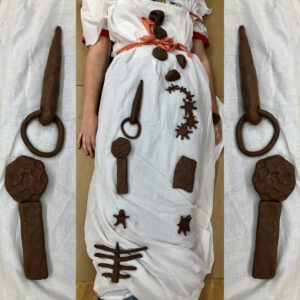 Dr Sally Waite: I am a Classical Archaeologist working to develop and promote the Shefton Collection of Greek and Etruscan Archaeology at the Great North Museum: Hancock. My research focuses primarily on Attic red-figure pottery and the long history of collecting and collections. I have published and exhibited on the collection, and supervise a number of PhD candidates working in related topics (see ‘Research’ tab). I teach a range of undergraduate and postgraduate classes across Classics and Archaeology (see ‘Teaching’ tab).
Dr Sally Waite: I am a Classical Archaeologist working to develop and promote the Shefton Collection of Greek and Etruscan Archaeology at the Great North Museum: Hancock. My research focuses primarily on Attic red-figure pottery and the long history of collecting and collections. I have published and exhibited on the collection, and supervise a number of PhD candidates working in related topics (see ‘Research’ tab). I teach a range of undergraduate and postgraduate classes across Classics and Archaeology (see ‘Teaching’ tab).
Dr. Olivia Turner: I am an interdisciplinary artist who lives and works between Gateshead and Newcastle upon Tyne. My diverse practice includes sculpture, drawing, video, printmaking and performance. I’ve recently completed a practice-led PhD at Newcastle University, with work on ‘Between Doctor, Patient and Cadaver: The Slippages of the Visceral Body in Medicine’. Since 2017, I’ve been working with the Wellcome Trust Centre for Mitochondrial Research—and I am now working with Dr. Waite as Lead for the Arts & Medical Research Cluster at Newcastle University.
TRANSCRIPT
DR BRANDY SCHILLACE: Hello and welcome back to the Medical Humanities Podcast. I’m so glad that you’ve joined us today because I have two really interesting people on, and we’re gonna be talking a little bit about art and about education and all sorts of things. This is Dr Sally Waite, who’s a senior lecturer in Greek Art and Archeology, and Olivia Turner, who’s an interdisciplinary artist, also a PhD who has been appointed the lead for the Arts and Medical Research Cluster at Newcastle University. Welcome to both of you. Thank you for joining me.
DR OLIVIA TURNER: Thanks so much for having us here, Brandy.
DR SALLY WAITE: Thank you.
SCHILLACE: It’s really good to have you on. I would love it if you could just tell us a little bit more about who you each are and what you do. But then, what we’re really here to talk about today is this idea of “corporal pedagogies.” So, Sally, could you say a few words about yourself?
WAITE: Yes. So, my research focuses on the material culture of ancient Greece. I’m a museum-based archeologist. I work with Newcastle University’s Shefton Collection. My specialism is Athenian red-figure pottery, and I focus particularly on issues related to identity and the body.
SCHILLACE: Right. That’s wonderful. And Olivia, I know that you’re an interdisciplinary artist. Could you say a bit more about that, too?
TURNER: Yeah. So, my practice is really interested in the body and its relationship to medicine, in particular this idea of the visceral body. But we can talk a bit more about that in a second. And my practice works with lots of different types of mediums, but in particular performance, sculptural installation, writing, and drawing. And it’s really, I’m very interested in how we work together in different disciplines and how particularly using workshops as a methodology for working together, that’s a real big part of my creative practice.
SCHILLACE: That sounds amazing. One of the things that really intrigues me about what both of you do really is this idea of bodies, embodiment, the stuffness, right? The sort of material lived experience of art and bodies and health. So, if we could take a moment, I know that you are working together on a project called Corporal Pedagogies, and partly, I’d love to know a little bit about what does that mean, and also how did it come about?
TURNER: So, the Corporal Pedagogies project came about from a project that I was doing a couple of years ago called The Visceral Body, and it was a Wellcome-funded project. And this really was starting to think about this idea of visceral, as I mentioned, and this idea of visceral as being caught between two meanings. So, on one hand, visceral within medicine is used to describe the literal location of the trunk organs in your body. But then you have the sort of metaphorical definition of visceral as being something felt within the body. And so, I became very interested in how, within medicine in particular, the visceral sort of caught between these two positions or these two definitions between how we imagine our bodily insides and how they objectively are.
And so, I became interested in how we might think about sort of subjective corporeal sensations, so how sensation forms a sort of internal vision of our body, and this being really around sort of this idea of proprioception, so how we form an internal sense of the body. And this is really a sort of continual but quite muted feeling of things happening inside. And so, this then became a sort of expansion on this idea of sensorial sight, so how we see through the senses. And it sort of brought questions around the body within medicine: how we form embodied knowledge, how we understand anatomy, and how we come to a sense of corporal expertise, so bodily expertise, and how this changes during illness and disease and has real life implications for patient studies, for instance. And so, I, as part of this project, set up a workshop in collaboration with Sally called The Way My Body Feels, thinking about how we can work through creative practice, archeology, and medicine, and how we can come together through those disciplines to think about teaching and research.
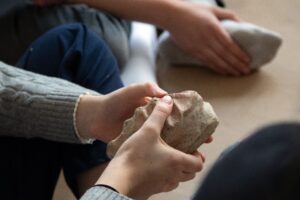
SCHILLACE: That is really fantastic and interesting. Sally, can you say a bit more about how this becomes kind of connected to museum archeology? I’m a little bit familiar with museum archeology, though, from a medical museum standpoint. But can you say more about that?
WAITE: So, the connection for us was this votive uterus, which we have in the Shefton Collection. So, this is a clay uterus. It’s about 15 centimeters long. It’s got a flat bottom. It’s a kind of pinky terracotta color, and it’s molded. The back of it is like a ridge. It almost looks like a rib cage. It’s a really strange looking object, and it just fits neatly into your hands. And so, Olivia was particularly interested in this object because obviously, it’s a representation of an internal body part. And so, that is what we began our collaboration with.
SCHILLACE: This is timely. I’m here in the United States, and as everybody knows, the Supreme Court has just overturned Roe versus Wade, meaning that a lot of autonomy women have had over their own uteruses has been lost. And so, I feel like the fact that the focus piece of your collection is a votive uterus has perhaps even greater meaning for me now than it did prior. So, I think that’s really interesting. And this concept that we feel our way through the body and who has expertise is related to issues of social justice as well.
TURNER: Absolutely.
WAITE: Exactly.
TURNER: Sorry, Sally. You go.
WAITE: No, exactly. And I think that part of our approach is very much embracing critical pedagogies, which takes into account these issues of social justice.
SCHILLACE: Mmhmm.
TURNER: And I think as well, as we’ll talk a bit about the format of the workshops in a moment, but as part of it, we’re being informed by a lot of different texts. And one of the key texts that we do some readings within the workshop is Elinor Cleghorn’s Unwell Women. And this, as you say, Brandy, feels so pertinent. But one of the, a tiny section in the end of the book just says, “The lives of unwell women depend on medicine learning to listen.” And I think what the workshops are trying to provide are spaces for listening to inform critical theory and practice.
SCHILLACE: Yes. And the other thing that strikes me as you’re talking is, I work a lot with the disability community as well, and I’ve been collecting responses to the overturning of Roe v Wade from the disability community. That’s a group of people who are often treated as though they’re not experts on their body or don’t have autonomy over their bodies, even though, particularly in the case of chronic or misunderstood illnesses, they’re often the only expert on their body. And so, this concept that there’s groups of people who are already—women, minorities, disabled people, chronically ill people—who already struggle to maintain any kind of autonomy in the face of medical practice or social or the legal system even, in the face of these restrictions, it seems now more than ever we should be focusing on them. And yet, frequently, even in response to loss of access, you don’t hear from those particular, those exact groups of people.
WAITE: I think it—
TURNER: Yeah. Sorry!
WAITE: I think it’s true. And I think that one of the things that’s so interesting about this Greek votive offering is, of course, the voices of women are silenced from antiquity. And yet, this votive gives us a way to begin to understand something about their lives and potentially even about their feelings.
SCHILLACE: Mmhmm, mmhmm. In an ob—, in a…. Well, [chuckles] if you feel your body is objectified already, and then you have an object that represents the body, there’s something to be said about that. It’s a very, very interesting intersection.
WAITE: And these votive wombs are the most common internal body organ. So, other organs are represented and also parts of the exterior body, but the womb is by far the most common of these.
TURNER: I think as well, because as Sally said, in relationship to our votive uterus, it doesn’t—and this reference to a rib cage—it doesn’t look at all [laughs] like a womb, you know, an anatomic— There is no anatomical correctness to this object. And so, it’s really interesting how this object already is beginning to push itself away from the objectification of our bodies. And I think something that has been really strong throughout all the workshops that we’ve done is this process of externalization. So, by externalizing a part of oneself, how do we then come to terms with it? How might it, through handling and looking at it differently, provide sort of moments of healing or moments of thinking about this thing differently? And as you said, something that takes into account its thingness beyond just simple sort of descriptions about it.
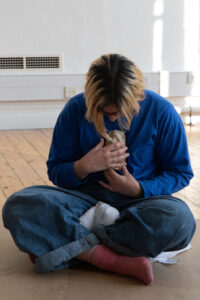
SCHILLACE: Yeah. Well, the living body and then also the object together, interacting. I think sometimes the divisions between are not perhaps as fixed as we like to suppose. And there’s social justice aspects of that, but there’s also other issues to look at in how we conceptualize the insides and outsides of our body and the borders of our body. Stuart Murray has a project on right now called LivingBodiesObjects that’s won a big Wellcome grant recently, and I know they’re still in process of even asking questions about how we ask questions. So, this concept that bodies and embodiment and feeling that body and proprioception, all of this is, I think, very much in the, it’s right that it’s being a focus right now. And I think it makes sense that we’re focusing on it. You think about trans lives, you think about women’s rights, you think of all of these things which are right now both very present and also potentially under threat, a workshop like this one that is suggesting this needs to be part of our pedagogy seems critically important.
TURNER: Absolutely. I think as well, it’s, you know, when we were working with university students, a discipline that we were really keen to work with within this was medicine and psychology. And it’s exactly for the reasons that you were stating earlier of, you know, it’s not just a case of needing to amplify the voices of people who are trying to advocate for their own bodies. But how do we actually change the culture or the ways in which we think about the body within the disciplines who are the ones who are making decisions on behalf of us? So, I think that was also a very key point of intersection for this project.
SCHILLACE: That’s awesome. Well, what I’d love to do in the last 10 minutes or so is hear from you about how did these workshops, you know, what was the format? But more specifically, what did you learn from them? What came out of them? What sorts of, you know, will this direct your course in the future?
WAITE: Yes. Shall I start with the beginning? So, we begin the workshop with the object handling. And obviously, we were working with students from several disciplines, and many of them hadn’t handled ancient materials before. So, we passed around the artifact, and we spent quite a bit of time doing this. And each student made an observation about it, and the observations focused on things like the color, the shape, the size, the weight, so the things that were visible to the senses, particularly to sight and touch.
And then when we had done that, we returned to ask the participants to give an emotional response to the handling of the object. And this was where some really interesting things began to emerge that we hadn’t anticipated at this stage of the workshop. This is a question I would never ask my archeology students, to connect emotionally with an object. And yet, of course, that’s something we do when we handle an object. So, this was quite moving. And then from there, we moved into a meditation. Olivia, do you want to talk a little bit about that and the rest?
TURNER: Yeah. So, from this, we worked with two meditation experts, Michael Atkinson and Jessica Combs. And it was important for…because we were trying to disrupt this sort of convention within Western university settings of sort of like focusing on this idea of intellect or knowledge as being only sort of cerebral or…. So, we were trying to disrupt that, and so meditation formed a really important part to provide a way in which we could begin to tune in to the body and also to just feel together in a space, if that make sense.
SCHILLACE: No, it does.
TURNER: So, there’s something that comes about by being quiet and reflective and within this sort of meditative, a guided meditative state where you begin to allow inhibitions or tensions or things that might get in the way of you enjoying or engaging with this type of teaching. And so, it sort of allowed everyone to come together and really set the tone of the rest of the day. And it was very interesting that that was a very crucial moment that we had in feedback as well, that that was one of the crucial moments of allowing students to just let themselves go.
And so, from the meditation, we then began to think about how we would work together as a group. And this really was important in relationship to things that underpinned anatomical votives. So, Sally might want to talk a bit more about this, but this idea of it being an individual experience, but this notion of a collective body.
SCHILLACE: Mmhmm.
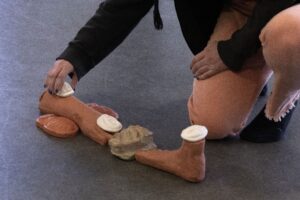
TURNER: So, we were creating these things called scores, which are very sort of key moments within the history of art around this Fluxus movement, so this 1960s experimental art movement. And the idea of scores were a way in which we can begin to use art and make the sort of democratic way which we can, which anyone can join in with. And so, scores came about from rather than using musical notation, which you create a piece of music, but then another musician can play, you put together a sentence or a simple piece of text, that then anyone can perform with. So, this came, we were sort of responding to each other, to actions, to moving in a space, and to the object itself.
And so, some of the examples of the scores that were made were, “Share a connection that you are grateful for.” And another was, “Select and clasp part of your body you do not normally notice. See how you can entwine your fingers around it.” So, we would do this together. We would experience this together. And so, again, thinking about this relationship between individual and social bodies, particularly around ideas of illness and disease. And Sally, I don’t know if you wanna talk a bit about that, how that relates to votives.
SCHILLACE: Let me just [inaudible] say, I find the haptic part of this really interesting, that you do some costume making and clay work and things like that. And I definitely want us to talk a little bit about the feedback and participant evaluation before we run out of time. So, Sally, could you start off by talking about how this connects with the votive object? And then could we maybe hear a little bit about how the participants themselves kind of responded?
WAITE: Yes, absolutely. So, we were thinking about, with the ancient votive offering, which is given to the gods in petition or as a thanks for a healing or a successful childbirth, we were thinking about how these were displayed in antiquity, and some of the objects have suspension holes. So, we did a visualization exercise to imagine what it would’ve looked like, all these suspended body parts and then body parts standing on the floor or on shelves. And the idea that these individual body parts come together to make a collective whole in the display, so creating the idea of a communal body, which is what we were trying to do with the scores. Olivia then analyzed all the feedback. So, I’ll hand back to you, Olivia, for this bit. [chuckles]
TURNER: Yeah. So, as Brandy’s touched upon, there was this real sense of sort of haptic learning and teaching. And so, we moved from costume making as a sort of way to record the marks made from the clay during the day, as well as a sort of expression, like playful expression of self. And the colors were chosen specifically as these pinks and terracotta colors to relate to the materiality of the clay. So, it was really sort of pulling everything in together.
And so, then we moved on to working with terracotta clay itself, and the students were asked to lie down. And we went from having sort of individual experiences where I would read these texts such as Sinéad Gleeson, Anne Boyer, and as I said before, Elinor Cleghorn. And as these were being read aloud, the students would take a piece of clay and begin to just close their eyes and impress sensations and feelings into it. And it wasn’t really about what they made, but it was about thinking around process and considering the materiality of the body in relationship to the votive.
And so, after this individual experience, we then asked them to have one student lie down, and the rest of us would gather around them and begin to make small objects in relationship to either opting for pressure on the body, or if they had any pain, or if they had a particular sensation happening, we would all make these very small sort of objects responding to the person who was in need of them on their body. And we had them laid out with all these tiny objects placed all over them.
And this was a really, really amazing experience for both Sally and I, as well as the students and for us really about understanding this sort of transformative role objects can play within education and how valuable this type of learning is. And some of the students, well, all of the students really, had come back and said that this actual handling of an ancient object was such a powerful and unique experience because we don’t normally engage with collections in this way. And they spoke about this idea of being emotionally connected to the past and how bringing together different expertise of archeologists, creative practice, meditation, how that really was important to get a full, holistic understanding of these objects and their role within society today and how each of these things that we did within these workshops, how they then related to the disciplines themselves.
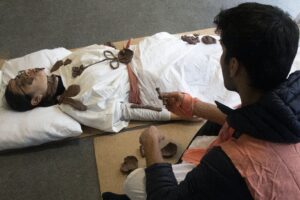
And so, they spoke about this idea of having, bringing emotional intelligence to academic subjects, which I think was such an interesting way of phrasing it. And I think for us, it just really, as I say, it really was reaffirming the importance and necessity of this learning experience within university settings and beyond. I mean, these workshops could go anywhere into any spaces, really, and thinking about how interdisciplinary collaboration is so valuable for thinking about the body and its relationship to objects.
SCHILLACE: And to medicine, because I think we have an unfortunate tendency to have a sort of top down, the doctor has the knowledge, and the patient is a recipient rather than a collaboration. And so, these collaborations seem like those would be really important for medicine, too, which is partly what makes the Medical Humanities such a useful field.
Sally, what did you take away from this, and how do you see this potentially impacting things in the future?
WAITE: I could say honestly that it was the best teaching experience I ever had, and I’ve been teaching for over 20 years. And I mean, partly it was having the students for the whole day, which we normally just get an hour or two at the most. So, it was a fully immersive experience. Partly it was because it broke down the hierarchies. We didn’t have set-year groups. We nixed first years to PhDs. And also, Olivia and my role wasn’t that of the kind of teacher. It was much more collaborative and learning together. So, it was a huge learning curve and a completely different way of teaching, which I would love to do more of. Unfortunately, the way that the university system is set up doesn’t facilitate this kind of interdisciplinary or mixed cohort or lengthy, whole-day workshops.
SCHILLACE: See? That’s why we need to completely overhaul education. I was talking to Olivia about this earlier. [laughs] But no, this has been really informative and really amazing. And I think that your workshop says a lot for why the Medical Humanities or Health Humanities—actually, I like to think of it as Health Humanities ‘cause I think that’s more broad—is so valuable for reconnecting us in an often disconnected world. And I see many, many applications for bringing social justice even more firmly into that discussion as we talk about who has the expertise over bodies, whose expertise matters. And I think all that’s really, really valuable. So, I just wanna thank both of you for being on with me today and for sharing this amazing experience. I hope that you’ll join us again some time. It was good to have you.
WAITE: Thank you.
TURNER: Thank you so much. Thank you.
SCHILLACE: And to all of our listeners, thank you once again for being part of the conversation.